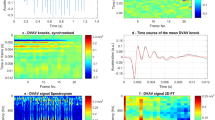Abstract
IN observation hives worker honey-bees may often be seen to perform a behaviour pattern called dorsoventral abdominal vibration (DVAV)1, the jerking dance2, or shaking3. It has been suggested4–6 that it serves to prepare bees for flight, mainly on the grounds that the only occasions on which queen honey-bees are vibrated (subjected to DVAV) are before their orientation and mating flights and before swarming. But conclusive evidence has not been provided, and von Frisch regards the function of DVAV as still being obscure2. Gahl7 also leaves this question open.
Similar content being viewed by others
References
Milum, V. G., Am. Bee J., 95, 97–104 (1955).
Frisch, K. von, The Dance Language and Orientation of Bees (Belknap, Cambridge, Massachusetts, 1967).
Allen, M. D., Nature, 181, 68 (1958).
Allen, M. D., Anim. Behav., 7, 66–69 (1959a).
Allen, M. D., Anim. Behav., 7, 233–240 (1959b).
Hamman, E., Insectes Sociaux, 4, 91–105 (1957).
Gahl, R. A., Anim. Behav., 23, 230–232 (1975).
Author information
Authors and Affiliations
Rights and permissions
About this article
Cite this article
FLETCHER, D. Significance of dorsoventral abdominal vibration among honey-bees (Apis mellifera L.). Nature 256, 721–723 (1975). https://doi.org/10.1038/256721a0
Received:
Accepted:
Issue Date:
DOI: https://doi.org/10.1038/256721a0
- Springer Nature Limited
This article is cited by
-
Extensive Vibrational Characterisation and Long-Term Monitoring of Honeybee Dorso-Ventral Abdominal Vibration signals
Scientific Reports (2018)
-
The effect of repeated vibration signals on worker behavior in established and newly founded colonies of the honey bee, Apis mellifera
Behavioral Ecology and Sociobiology (2009)
-
Events following queen removal in colonies of Africanized honeybees in South America
Insectes Sociaux (1979)





